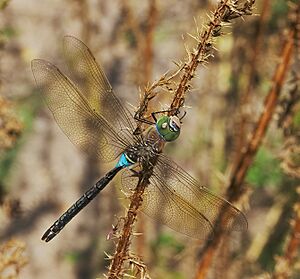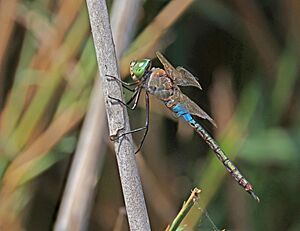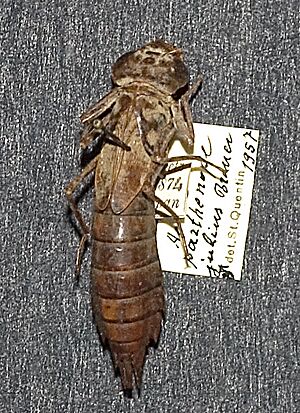Lesser emperor facts for kids
Quick facts for kids Lesser emperor |
|
|---|---|
 |
|
| Male | |
| Conservation status | |
| Scientific classification |
The Lesser Emperor (scientific name: Anax parthenope) is a large, beautiful dragonfly. It belongs to the family Aeshnidae, which are often called "hawker" dragonflies. You can find these amazing insects in many parts of the world, including Southern Europe, North Africa, the Middle East, and across Asia.
Contents
Meet the Lesser Emperor Dragonfly
The Lesser Emperor is a fascinating insect that is often active when the sun is setting, during dusk. It has some special features that help you tell it apart from other dragonflies.
What Does It Look Like?
- Face and Eyes: Its face and the front part of its head are usually a greenish-yellow color. Its eyes are bright green, but they can turn a bit bluish as the dragonfly gets older.
- Body Colors: The main part of its body, called the thorax, is a light brownish-green.
- Abdomen: This is the long tail-like part.
- The second segment (section) of its abdomen is a pretty turquoise blue.
- The third segment has a big blue patch on each side.
- Segments four to nine have a black stripe down the middle.
- The very last segment, number ten, is black.
Lesser Emperor vs. Other Dragonflies
The Lesser Emperor looks a lot like another famous dragonfly, the Emperor Dragonfly. But there are a few ways to tell them apart!
How to Spot the Difference
- Size and Color: The Lesser Emperor is generally smaller and not as brightly colored as the Emperor Dragonfly.
- Abdomen Position: When flying, the Lesser Emperor tends to hold its abdomen (its "tail") straighter. The Emperor Dragonfly often flies with its abdomen bent downwards. So, if you see a large dragonfly with a bent abdomen, it's probably an Emperor!
- Blue Saddle: The Lesser Emperor has a clear blue patch on the second and third segments of its abdomen. This "blue saddle" stands out against the rest of its brown abdomen. It also has a yellow ring at the base of its second segment.
- Eyes: The Lesser Emperor has green eyes.
Comparing to Anax ephippiger
The Lesser Emperor is also similar to another dragonfly called Anax ephippiger.
- A. ephippiger is a bit smaller and thinner.
- Its blue patch on the second abdomen segment is mostly on top, not wrapping around the sides like the Lesser Emperor's.
- A. ephippiger has brown eyes.
Where Lesser Emperors Live
This amazing dragonfly lives in many places! You can find it across southern and central Europe, including most islands in the Mediterranean Sea. It also lives all the way across Asia to Japan, the Korean Peninsula, and China. You can even spot them in North Africa, the Canary Islands, and the Madeira Archipelago.
Lesser Emperors are spreading northwards. They were first seen in Great Britain in 1996 and have been breeding there since then.
Their Favorite Homes
Lesser Emperors love to be near still water. You'll often see them flying around:
- Ponds
- Lakes
- Other calm water bodies
They sometimes share their homes with Emperor Dragonflies, but usually, there are fewer Lesser Emperors around. If both types are in the same pond, the Emperor Dragonfly is usually the boss!
Life Cycle and Behavior
In warmer parts of the world, Lesser Emperors can start flying as early as March. They are most commonly seen from June to September, but you might still spot them in November.
Reproduction
Dragonflies have a unique way of mating.
- Males and females mate in a special way that looks like a heart shape.
- After mating, the male and female often stay connected while the female lays her eggs. This is called "in tandem" egg-laying.
- They lay their eggs by carefully placing them into plants or soft mud near the water.
- The eggs usually hatch after about two months.
Larval Stage
- Once the eggs hatch, tiny dragonfly babies called larvae (or nymphs) come out.
- These larvae live underwater and grow for about two years before they are ready to become adult dragonflies.
Images for kids









